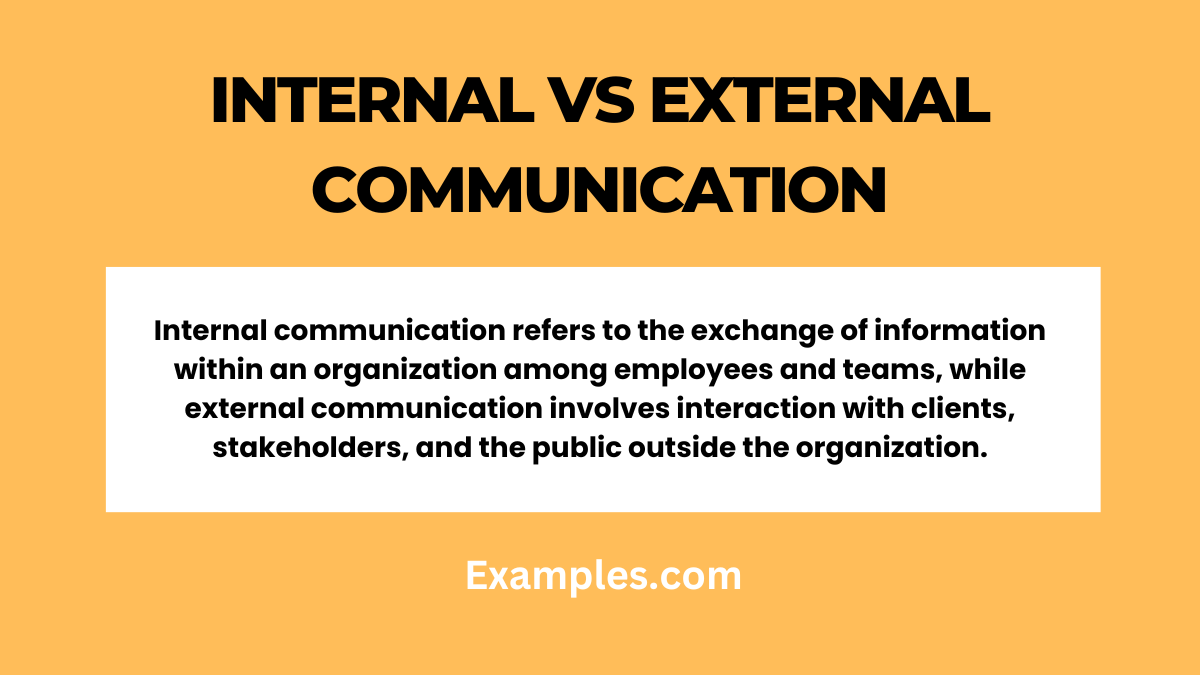Internal vs External Communication – Examples, Tips
Explore the distinct yet interconnected worlds of Internal vs External Communication through this comprehensive guide. It offers a deep dive into how these two facets of communication operate within a business context, complete with Internal Communication Examples. You’ll learn about their unique functions, the interplay between them, and how mastering both is crucial for organizational success. This guide is an essential resource for understanding and improving your organization’s communication strategy, both internally and with the wider world.
Internal vs External Communication

Internal vs External Communication refers to two distinct but essential types of communication in an organization. Internal communication is the exchange of information and ideas within an organization, among its employees. It’s crucial for effective team collaboration, maintaining morale, and ensuring everyone is aligned with the company’s goals. On the other hand, external communication involves interaction with people outside the company, such as customers, suppliers, investors, and the public. This type of communication helps in building the company’s brand, managing its reputation, and maintaining relationships with external stakeholders. Both types are integral to the success of any business and play key roles in Internal Communication Functions and Public Relations.
Examples of Internal and External Communication
Understanding the best examples of Internal and External Communication is crucial for grasping their impact and importance in the business world. These examples illustrate how effective communication strategies can enhance organizational performance and public perception.

Internal Communication Examples:
- Employee Newsletters: Regular newsletters keep employees informed about company news, achievements, and updates, fostering a sense of belonging and engagement.
- Intranet Platforms: Digital platforms like an intranet are used to share information, resources, and facilitate internal discussions, enhancing Internal Communication in Organizations.
- Regular Team Meetings: Scheduled meetings allow for sharing updates, discussing challenges, and brainstorming solutions, crucial for maintaining team unity and focus.
- Internal Feedback Surveys: Surveys help gather employee feedback on various workplace issues, reflecting the Importance of Internal Communication in understanding and addressing employee concerns.
External Communication Examples:
- Press Releases: Companies use press releases to announce significant events, product launches, or company achievements, playing a vital role in shaping public perception and Internal vs External Communication strategies.
- Social Media Engagement: Active presence and engagement on social media platforms help in building brand awareness and interacting with customers, illustrating Internal Communication Techniques adapted for external audiences.
- Customer Newsletters and Emails: Regular newsletters and emails to customers keep them informed about new products, offers, and company news, strengthening customer relationships.
- Public Relations Campaigns: PR campaigns are designed to enhance a company’s public image and manage its reputation, showcasing Internal Communication Best Practises adapted for external stakeholders.
These examples of Internal and External Communication highlight how each serves specific functions and audiences but are equally important for the holistic success of a business. Effective management of both is essential for achieving organizational goals and maintaining a positive public image.
The Benefits of Internal and External Communication
Delving into the benefits of Internal and External Communication reveals their critical roles in the success of any organization. Internal communication strengthens the backbone of the company, enhancing team dynamics and operational efficiency. Externally, communication shapes the public perception and relationships with clients and stakeholders. Grasping these benefits is crucial for harnessing the full potential of Internal Communication Functions and External Communication Strategies.

| Aspect | Benefits of Internal Communication | Benefits of External Communication |
|---|---|---|
| Employee Engagement | Enhances employee morale and engagement through clear, transparent communication. | Not directly applicable. |
| Team Collaboration | Facilitates better teamwork and collaboration within the organization. | Improves relationships with business partners and collaborators. |
| Operational Efficiency | Leads to improved efficiency in operations due to better coordination and clarity. | Not directly applicable. |
| Organizational Alignment | Ensures that all employees are aligned with the company’s goals, values, and policies. | Helps align public perception with the company’s values and objectives. |
| Conflict Resolution | Aids in quicker resolution of internal conflicts and misunderstandings. | Helps manage and resolve conflicts or misunderstandings with external stakeholders. |
| Change Management | Facilitates smoother implementation and acceptance of organizational changes. | Assists in effectively communicating changes or developments in the company to the public and other stakeholders. |
| Brand Image and Reputation | Indirectly influences the external perception of the brand through employee advocacy and satisfaction. | Directly builds and maintains the company’s public image and reputation. |
| Customer Relationships | Not directly applicable. | Strengthens customer loyalty and trust through consistent and honest communication. |
| Market Reach and Expansion | Not directly applicable. | Enhances market reach and facilitates business growth through targeted communication strategies. |
| Feedback and Innovation | Encourages feedback from employees, leading to innovation and continuous improvement. | Gathers valuable feedback from customers and the public, guiding business strategy and product development. |
| Crisis Management | Ensures internal readiness and a unified approach to managing external crises. | Effectively manages public perception and information dissemination during crises. |
| Talent Attraction and Retention | Promotes a positive work environment, attracting and retaining top talent. | Builds a strong employer brand, attracting potential employees and retaining existing talent through positive brand image. |
- Benefits of Internal Communication:
- Enhances Collaboration: Effective internal communication fosters teamwork, making it easier for employees to work together towards common goals.
- Boosts Employee Morale: Regular and transparent communication can improve employee morale and job satisfaction.
- Facilitates Better Decision-Making: When employees are well-informed, they can make decisions more efficiently and effectively.
- Aids in Conflict Resolution: Open lines of communication help in addressing and resolving workplace conflicts swiftly.
- Supports Change Management: Effective internal communication is crucial for managing organizational changes smoothly.
- Benefits of External Communication:
- Builds Brand Reputation: Consistent and positive communication with external stakeholders enhances a company’s reputation.
- Strengthens Customer Relationships: Engaging with customers through various communication channels helps in building long-term relationships.
- Attracts Potential Investors: Clear and transparent communication can attract and retain investors.
- Facilitates Market Expansion: Effective external communication is essential for exploring and establishing new markets.
- Enhances Public Relations: Strategic external communication is crucial for public relations and managing the public perception of the business.
How does Internal and External Communication Affect Each Other?
The relationship between Internal and External Communication is a dynamic interplay that significantly impacts an organization’s health and public image. The effectiveness of internal communication can directly influence external messaging and vice versa. Understanding this connection is essential for ensuring consistent and authentic communication, reflecting an organization’s true values and mission. This synergy is pivotal in maintaining effective Internal vs External Communication, crucial for any business’s success.
- Reflecting Internal Culture Externally: The internal communication culture of an organization often reflects in its external communication. A positive internal environment tends to lead to more positive interactions with external stakeholders.
- Consistency in Messaging: Consistency in internal and external messaging is crucial. What is communicated internally often sets the tone for external messages.
- Feedback Loop: External communication can influence internal policies and vice versa. Feedback from customers and stakeholders can lead to internal discussions and changes in strategy.
- Brand Alignment: Ensuring that internal understanding of the brand aligns with how it’s communicated externally is vital for brand integrity and consistency.
- Crisis Management: How a crisis is handled internally will often affect external communication strategies. A well-informed and unified internal front is essential for effective external crisis communication.
- Employee as Brand Ambassadors: Employees who are well-informed and satisfied with internal communication can act as brand ambassadors in their external interactions.
In summary, both Internal and External Communication play pivotal roles in the functioning and success of an organization. They are deeply interconnected, with each influencing and reinforcing the other. Balancing and optimizing these forms of communication is crucial for achieving business objectives and maintaining a strong brand image.
Internal vs External Communication are both vital to an organization’s success, each serving unique yet interconnected roles. This guide has highlighted their respective benefits and the impact they have on each other, emphasizing the need for a balanced approach. Mastering both internal and external communication strategies is crucial for fostering a strong organizational culture and maintaining a positive public image, ultimately driving business growth and success.
Tips on Effective Internal and External Communication
Effective communication, both internal and external, is a key driver of success in any organization. Here are some essential tips to optimize these vital communication channels:
- Clearly Define Objectives: For both internal and external communication, clearly define your objectives. Knowing what you want to achieve will help you tailor your messages effectively.
- Understand Your Audience: Tailor your communication style to suit your internal audience – your employees, and your external audience, which could include customers, investors, and the public.
- Choose the Right Channels: Utilize appropriate channels for different types of communication. Internal communication may thrive on emails, intranets, and team meetings, while external communication may require press releases, social media, and official statements.
- Consistency is Key: Ensure consistency in your messaging across both internal and external platforms. Consistent messaging helps in building trust and a strong brand image.
- Encourage Feedback: For internal communication, create an environment where feedback is encouraged and valued. Externally, listen to customer feedback and respond appropriately to maintain a positive relationship.
- Regular Updates and Transparency: Keep your employees informed about company news and updates, fostering transparency. Similarly, keep your external stakeholders updated on your company’s developments.
- Develop Strong Listening Skills: Effective communication is not just about conveying information, but also about listening. Encourage active listening within your teams and practice it in your external interactions.
- Train Your Team: Regular training sessions can enhance communication skills among employees, which will, in turn, improve their interactions with external stakeholders.
- Monitor and Adapt: Regularly assess the effectiveness of your communication strategies and be ready to adapt based on feedback and changing circumstances.
- Crisis Communication Plan: Have a robust crisis communication plan in place for both internal and external stakeholders to handle any unforeseen situations effectively.
Implementing these tips will enhance both Internal and External Communication, ensuring a coherent and effective approach that supports your organization’s goals and strengthens its reputation. Balancing these two aspects of communication is crucial for the long-term success and sustainability of any business



